The Brazil-Falklands/Malvinas Confluence (BFMC), a highly energetic convergence of surface currents in the western South Atlantic, has shifted southward in recent years and this shift is projected to progress in the future. Palaeoecological insights documenting past changes of these currents may help in anticipating future impacts on the environment. We used dinoflagellate cyst analyses from a marine sediment core to reconstruct environmental changes in the Argentine continental margin, western South Atlantic, during the last ca. 12,600 years. The dynamics of the BFMC were reconstructed using the relative frequency of warm-water indicators for the Brazil Current (BC) versus cold-water taxa thriving in the Falklands/Malvinas Current (FMC). We found that the latitudinal position of the BFMC was relatively stable with only minor amplitude migrations between 12.6 and 8.7 cal kyr BP, followed by periods with stronger shifts to the south and the north until 0.66 cal kyr BP. After that, the BFMC shifted continuously to the south. The increase in freshwater algae abundance after ca. 5.7 cal kyr BP suggests an increase in precipitation over the adjacent Rio de la Plata drainage basin in south-eastern South America. As previously documented, such an increase in precipitation was probably related to a higher El Niño-Southern Oscillation frequency and longer, stronger El Niño events since the mid-Holocene. The dinoflagellate cyst record indicates a phase of the enhanced presence of nutrient-rich waters over the core site between ca. 6.3 and 5.7 cal kyr BP, as well as from 0.66 cal kyr BP to the recent. The highest eutrophication in the ocean surface occurred during the last ca. 100 years, most probably due to stronger human impact in the area of the Rio de la Plata drainage basin.
How to translate text using browser tools
8 July 2019
Shifts of the Brazil-Falklands/Malvinas Confluence in the Western South Atlantic During the Latest Pleistocene-Holocene Inferred from Dinoflagellate Cysts
Fang Gu,
Cristiano M. Chiessi,
Karin A. F. Zonneveld,
Hermann Behling
ACCESS THE FULL ARTICLE
It is not available for individual sale.
This article is only available to subscribers.
It is not available for individual sale.
It is not available for individual sale.

Palynology
Vol. 43 • No. 3
July 2019
Vol. 43 • No. 3
July 2019
climate change
Dinoflagellate cysts
Holocene
latest Pleistocene
ocean currents
South Atlantic





